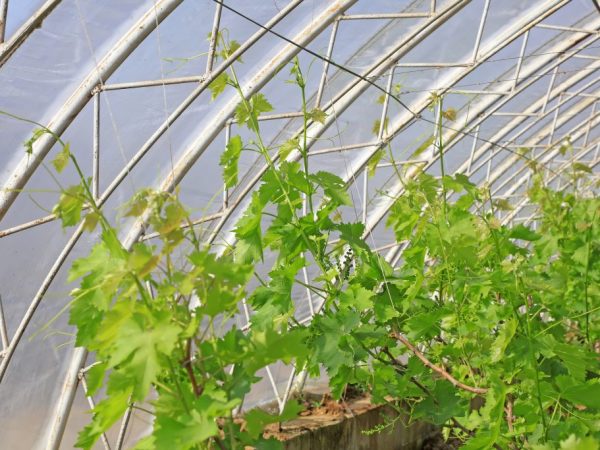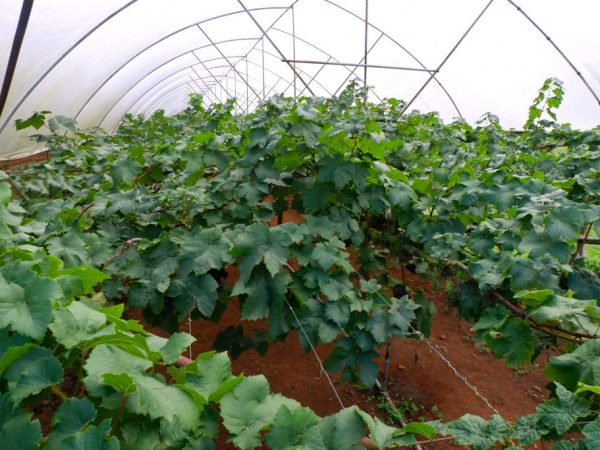Rules for growing grapes in a polycarbonate greenhouse
Breeders are developing new varieties of fruit for cultivation in cold regions. A line of such species has also been created for the southern berry. But in Siberia or the Urals, it is not always possible to grow berries in the open field, so it is necessary to grow grapes in a greenhouse. The optimal material is polycarbonate.

Rules for growing grapes in a greenhouse
Greenhouse benefits
Growing grapes in a greenhouse (especially in cold regions) is beneficial for several reasons:
- simplifies care in cold climates;
- allows you not to limit yourself in the choice of varieties;
- increases productivity;
- solves the problem of sheltering the vine for the winter.
Greenhouse for growing grapes made of polycarbonate - heavy-duty, durable, has a unique light transmission capacity, maintains the required temperature in the greenhouse.
A polycarbonate greenhouse has the following characteristics:
- Easy to use.
- It keeps the temperature well, which is good for winter, but in summer the temperature reaches 50 ℃. This forces you to think about the cooling system.
- It is easier to provide for a ventilation system, because the sheets of material are small.
- The material is fireproof.
Parameters and requirements for the greenhouse
When growing grapes in a greenhouse, you need to look after them. You can facilitate maintenance by setting some parameters for the greenhouse even at the planning and assembly stage:
- sufficient space for plants;
- ventilation in the corners of the structure;
- thermal insulation of plants in winter;
- the ability of the structure to withstand a layer of snow (so as not to dismantle the greenhouse in winter).
To facilitate the maintenance and care of the plant, the greenhouse must have the following capabilities:
- Additional ventilation for hot summer.
- The ability to heat the culture at low temperatures.
- Light adjustment methods (additional light sources).
- The mobility of the structure (the ability to assemble and disassemble it).
- Early planting of cuttings in the ground.

Plant health depends on the quality of the greenhouse
It is not easy to create a structure with your own hands, it requires certain construction skills and knowledge. A few tips to make it easier to build a greenhouse for grapes:
- Think in advance about the location of the bushes. Draw a diagram, calculate the footage.
- Choose a suitable location for your greenhouse. It is located on the south side of the site, the soil should not be swampy. Make sure that other structures do not create unnecessary shadows.
- Prepare materials and tools in advance.
- The optimal roof shape is a hemisphere. It allows you to make the most of the space and will not collapse under the snow in winter.
A properly built greenhouse will allow growing late varieties not only in the south, but also in cold climates.
Planting crops in a greenhouse
Also, follow the rules for planting and caring for grapes in the greenhouse. To begin with, you should plant a few grape bushes in the greenhouse, choose early varieties.
First, the soil is prepared: greenhouse soil is mixed with superphosphate and ash.The bushes should be planted at a distance of 70 cm from each other, and at a distance of at least 50 cm from the walls of the greenhouse. Landing holes are dug up to 40 cm deep. Planting technology using other techniques involves the creation of drainage.
Plant the cuttings in the warm ground in the spring. The greenhouse should be ready for planting time. If sudden frosts begin, the heating system will come in handy. When the vine takes root, standard care is carried out for it: shaping, watering, feeding.
In the greenhouse, make sure that the plants do not burn from excessive temperature and the scorching sun. The following temperature regime is suitable for grapes:
- When the buds begin to bloom 10 to 40 ℃ during the day, 8 ℃ to 10 at night.
- When shoots grow and the culture blooms 24-26 during the day, 14-16 ℃ at night.
- During ripening during the day 28-30 ℃, at night 18-20 ℃.
- At the same time, the soil temperature is not less than 20-25 ℃.
They also carry out treatment for pests and infections that appear in the culture. But their number, with proper care, will be significantly less than in the open field.
It is recommended to cover the vine for the winter with dry leaves (to avoid damping off) or perforated film. It is allowed to cover with coniferous leaves, sawdust. In addition, you should not cover the vine in the greenhouse with anything - the walls and roof with a layer of snow will maintain the optimal temperature regime.
If planting the first test bushes was successful, plant the greenhouse with the varieties you want the next year. Growing grapes in greenhouses increases the yield of early varieties, allows you to worry less about weather conditions.
Conclusion
With proper care, grapes in a greenhouse will grow even in Siberia and the Urals. In well-built greenhouses, it is possible to grow vineyards from the late southern varieties. When leaving, they follow the rules: they water, form a bush, and treat pests.


